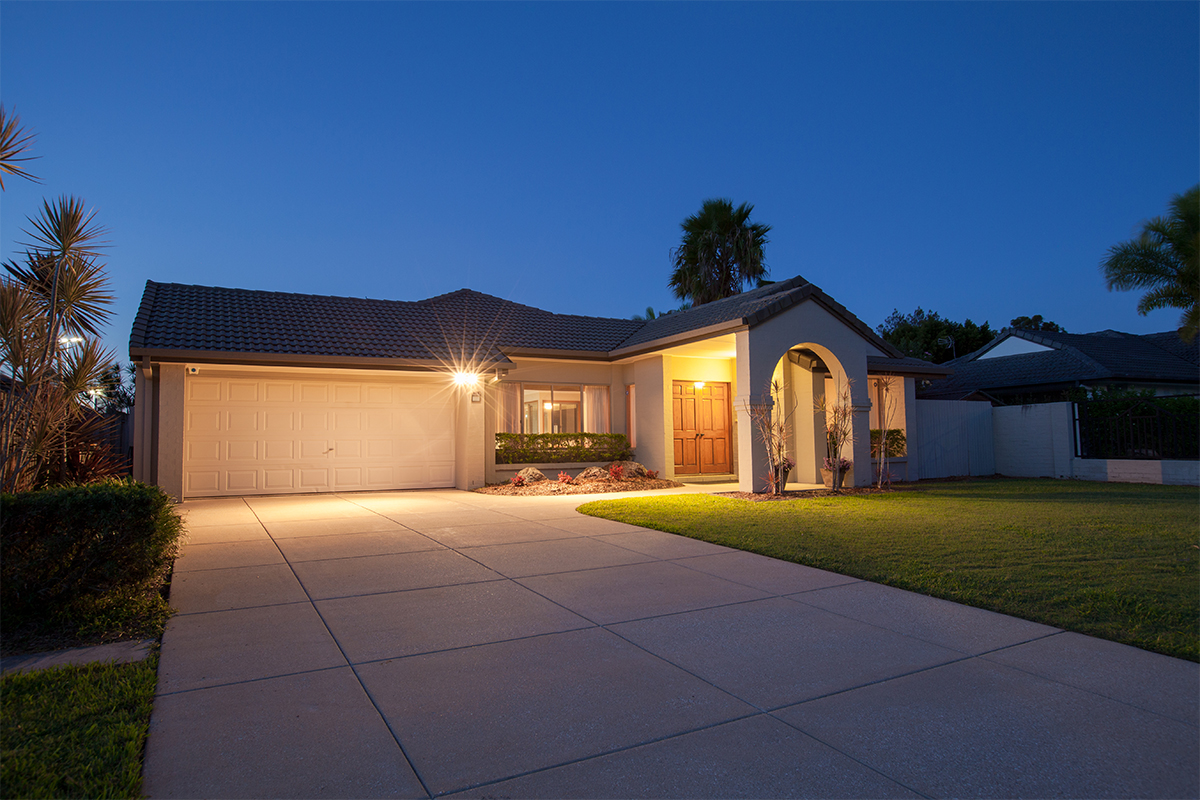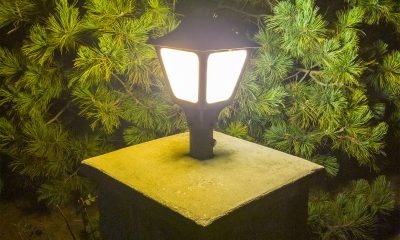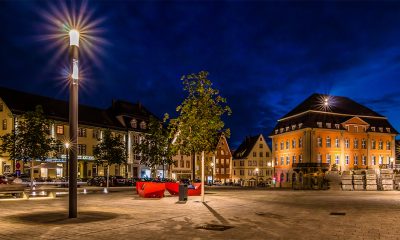What are outdoor motion sensor lights
Outdoor motion sensor lights are intelligent LED lights that can be automatically triggered to turn on by nearby movements. Outdoor lighting for residential spaces and commercial properties is a distinct application where energy efficiency, visual satisfaction, safety and security go hand in hand. Outdoor lights are used to illuminate a building’s exterior and the surrounding landscape to increase the usability of outdoor living spaces, to create visual expansion and continuity between the indoors and outdoors, and to bring a sense of safety and security to a dark yard. Creating an outdoor lighting solution requires designers to plan not only where the fixtures should be placed, but also when these lights should be activated. A good outdoor lighting solution puts the right amount of light where it is needed and when it is needed. Among the myriad of lighting control strategies, motion activated lighting provides the most cost-effective way to adapt lighting to real-time needs on an individual level.
Types of motion sensor lights
The family of motion sensor lights designed for illumination of a building’s or home’s exterior and surrounding landscape encompasses virtually all types of outdoor light fixtures.
- Outdoor security lights are floodlights or spotlights dedicated to discouraging intruder access attempts, heightening the effectiveness of nighttime video surveillance, and eliminating shadows that could offer concealment.
- Outdoor wall lights such as front and back porch lights also increase home security and safety while accentuating the architectural details and making a welcoming statement to visitors.
- Outdoor ceiling and hanging lights are installed on gazebos, porches and entryways to illuminate dining and seating areas and to extend the amount of time people can relax and socialize outdoors.
- Outdoor step light can be recessed into step risers, concealed underneath railings, or installed as surface lights on vertical posts to illuminate areas of foot traffic while highlighting the architectural elements around the pathway or other structure being targeted.
- Deck lights are installed flush on the deck boards to illuminate and accentuate outdoor entertaining spaces.
- Path lights and spread lights are used to frame out a space or feature in a yard while illuminating a safe passage to the building entrance.
- Post lights are used along pathways, walkways, and around gardens and pools, providing localized area lighting to prevent tripping hazards and highlight landscape features.
- Bollard lights are built to be both decorative and functional. They serve to create visual guidance and enhance the aesthetic appeal of the landscape.
LEDs and motion sensors are great companions
Motion-based controls had been struggling to find their feet in outdoor lighting applications that were the realms of incandescent lamps, compact fluorescent lamps (CFLs) and high-intensity discharge (HID) lamps then. Adaptive lighting based on motion sensing places a stringent demand on the electrical switch durability of the light source. The device stability of traditional light sources over long switching cycles remains a critical issue. Frequent on/off cycling can significantly reduce their rated lifetime.
As LED technology moves the boundaries of lighting performance to the next plateau, motion sensors started to make headlines in intelligent lighting applications. LEDs are electroluminescent devices that produce light through recombination of holes and electrons in InGaN quantum wells. These semiconductor devices are fundamentally controllable. They can be cycled on and off without delays in warm-up and restrike and work under any switching frequency without premature failures. With instantaneous dimming capability, LEDs bring a new level of flexibility in intensity control to outdoor lighting. Beyond improved source efficiency, LED outdoor lighting provides opportunities for additional energy savings through its highly controllable illumination.
What is a motion sensor
A motion sensor is switching or dimming lighting control that exercises control over the connected lighting load upon the occurrence of a sensing event. It detects movement within its range of sensitivity and measures changes in a targeted variable. The resulting change or stimulus is converted into a change in the output voltage which is referred to as an electrical signal. The electrical signal is then processed by electronic circuitry which filters signals from noise and amplifies the signal to a useful level. The amplitude of the signal is subsequently evaluated over a window comparator or by a digital light controller to determine whether this constitutes a motion. When the signal amplitude exceeds an established threshold, a control signal is generated to trigger a prescribed action. In the literal sense of the words motion detection is meant to detect movement of humans and interested objects only rather than presence (occupancy). The lights will be turned off or dimmed down after a user-designated time period if no movement is detected. If there’s a movement detected before the set time has elapsed, the delay timer will hold the lights on and the time delay will be reset.
The two major types of motion sensor
Motion sensors for use in outdoor lights can be categorized into active or passive devices based on whether they produce an energy output and then sense the response of the environment to that energy. Most outdoor motion detectors use either a passive infrared (PIR) sensor or an active microwave sensor to detect motion. The two technologies may also be used in conjunction to achieve maximum reliability. Dual-technology (DT) sensors activate lights only when both sensors detect the motion.
PIR sensors
A PIR sensor detects motion by measuring changes in infrared radiation emitted from objects that generate heat. The human body radiates electromagnetic energy in the infrared region (7 to 14 micrometers). The PIR sensor is designed to be maximally sensitive to electromagnetic waves in this range. The sensor itself does not emit any energy but can respond to infrared radiation by generating an electric charge. PIR sensors basically use the pyroelectric effect to distinguish a heat signature from the background. They are small, inexpensive and low-power devices capable of detecting full-body movement up to about 40 feet. These volumetric sensors require line of sight for detection. The highest sensitivity occurs in motions lateral to the sensor. The coverage area and sensitivity of a PIR sensor are controlled by the lens that distributes the IR energy. PIR motion sensors are relatively immune to false triggers, but they may fail to detect movement when dust or dirt to accumulate on the lens or the lens is or fogged. Extreme temperature changes can cause false alerts. Very slow motion can pose a challenge for PIR motion sensors.
Microwave sensors
Microwave sensors are commonly Doppler radars that send out ultra-high frequency radio waves known as microwaves and detect motion by measuring changes (shifts) in frequency of waves bounced off by a moving object within the detection zone. Electromagnetic waves are emitted from the signal generator (transmitter) and the detector (receiver) looks for a change in the reflected energy. This technology is active, volumetric, line-of-sight and more sensitive than PIR. Microwave sensors can detect extremely small movements, which makes them suitable for presence detection. Compared with PIR sensors, they have a significantly extended detection range and lend themselves to use in long, narrow, flat zones. The largest amount of Doppler frequency shift occurs when the motion is directly towards or away from the sensor. Therefore, microwave detectors have the highest sensitivity directly toward or away from the sensor. These active motion detectors work well in most weather conditions and are capable of passing microwave signals through many material types (except metal).
Embedded intelligence
A motion sensor light is generally a microcontroller-based LED system. A microcontroller (MCU) is employed as the light controller to interface between the motion sensor and the LED driver. The system-on-chip (SoC) integrates a CPU, memory and input/output (I/O) hardware to enable autonomous operation of the LED light engine without human interaction. It aggregates sensor information and creates instructions for the LED driver. The motion sensor can be connected either directly to the microcontroller after filtering and amplifying the electrical signal leveraging an analog-to-digital converter (ADC), or to a comparator and trigger the microcontroller using an interrupt.
The LED driver executes various instructions originated by the microcontroller to regulate the load. A radio transceiver is usually integrated into the SoC, allowing the microcontroller to run a wireless communication protocol to enable remote control and programming with a smartphone or tablet via a mobile app. Most outdoor motion sensor lights are designed with an ambient light sensor (ALS), often known as photocell or photosensor, to perform dusk-to-dawn control.



















Loading...